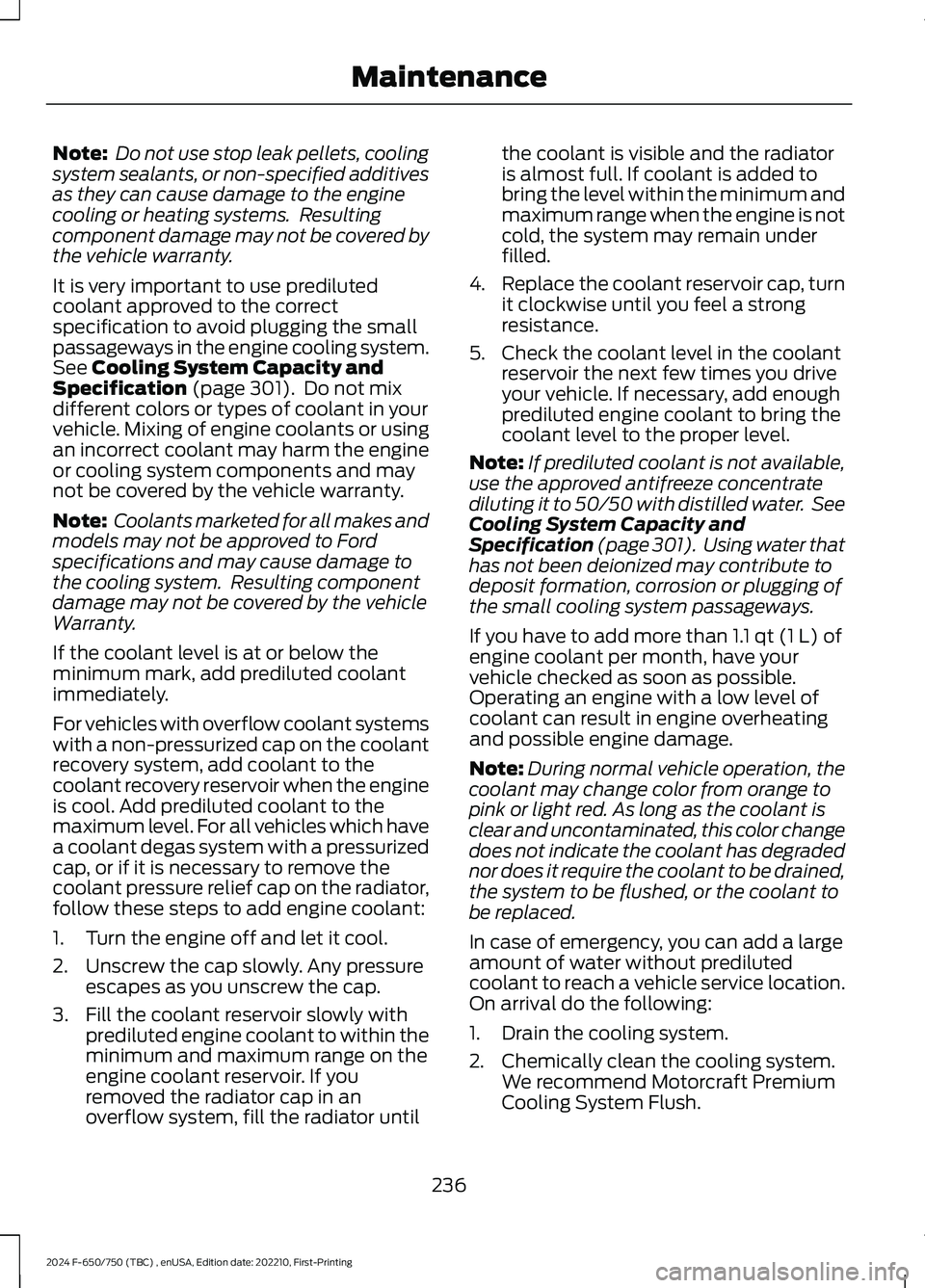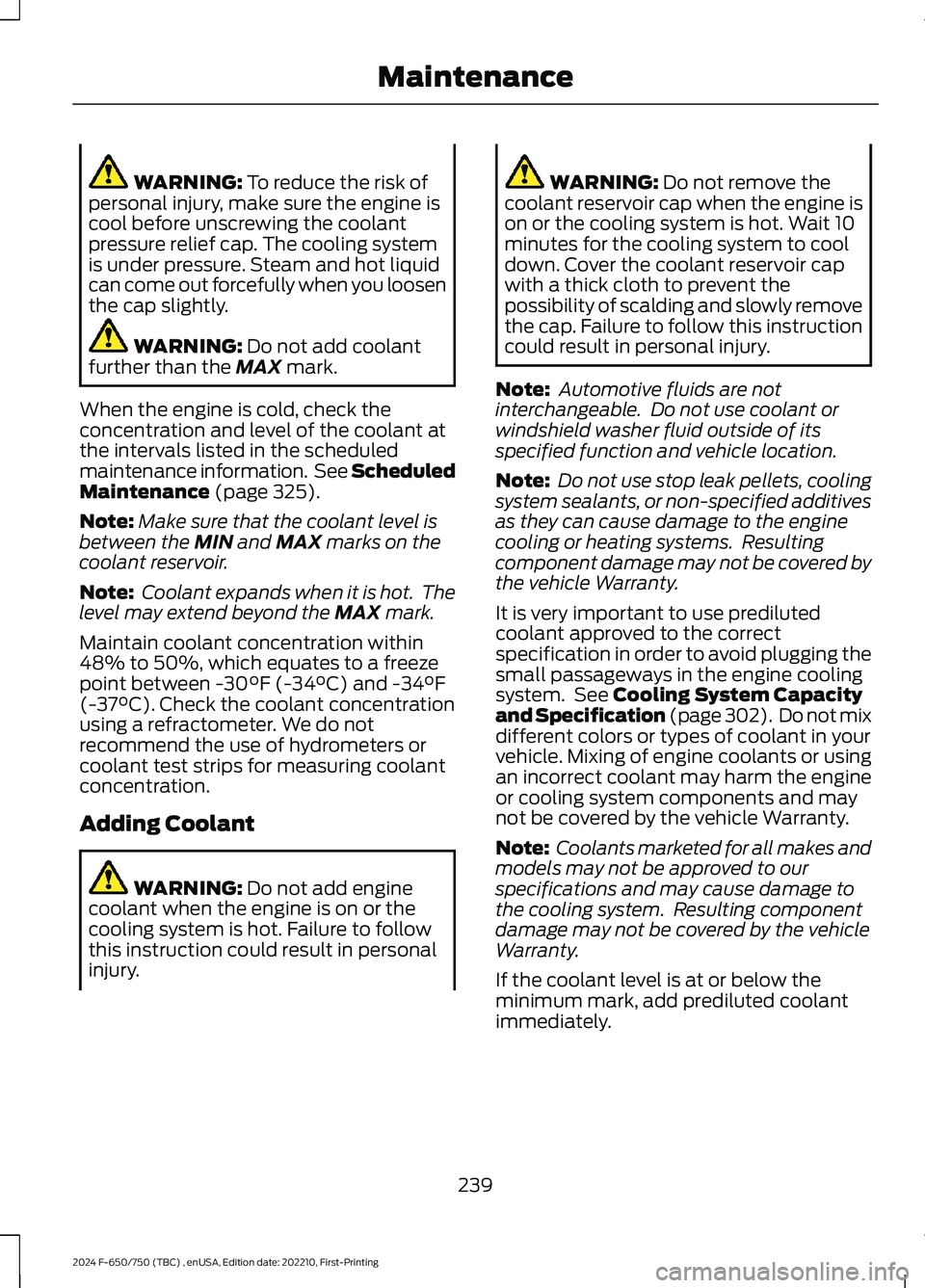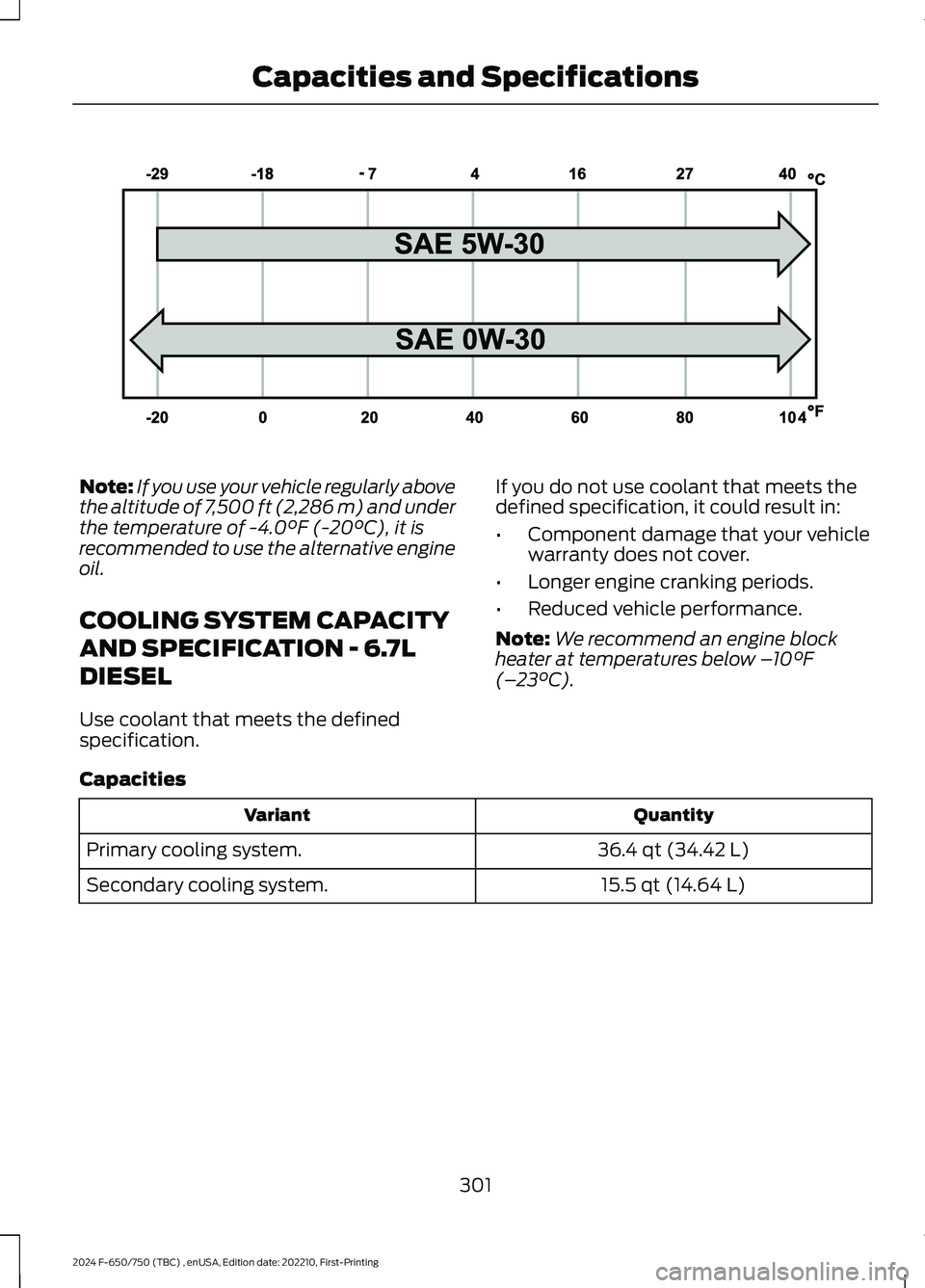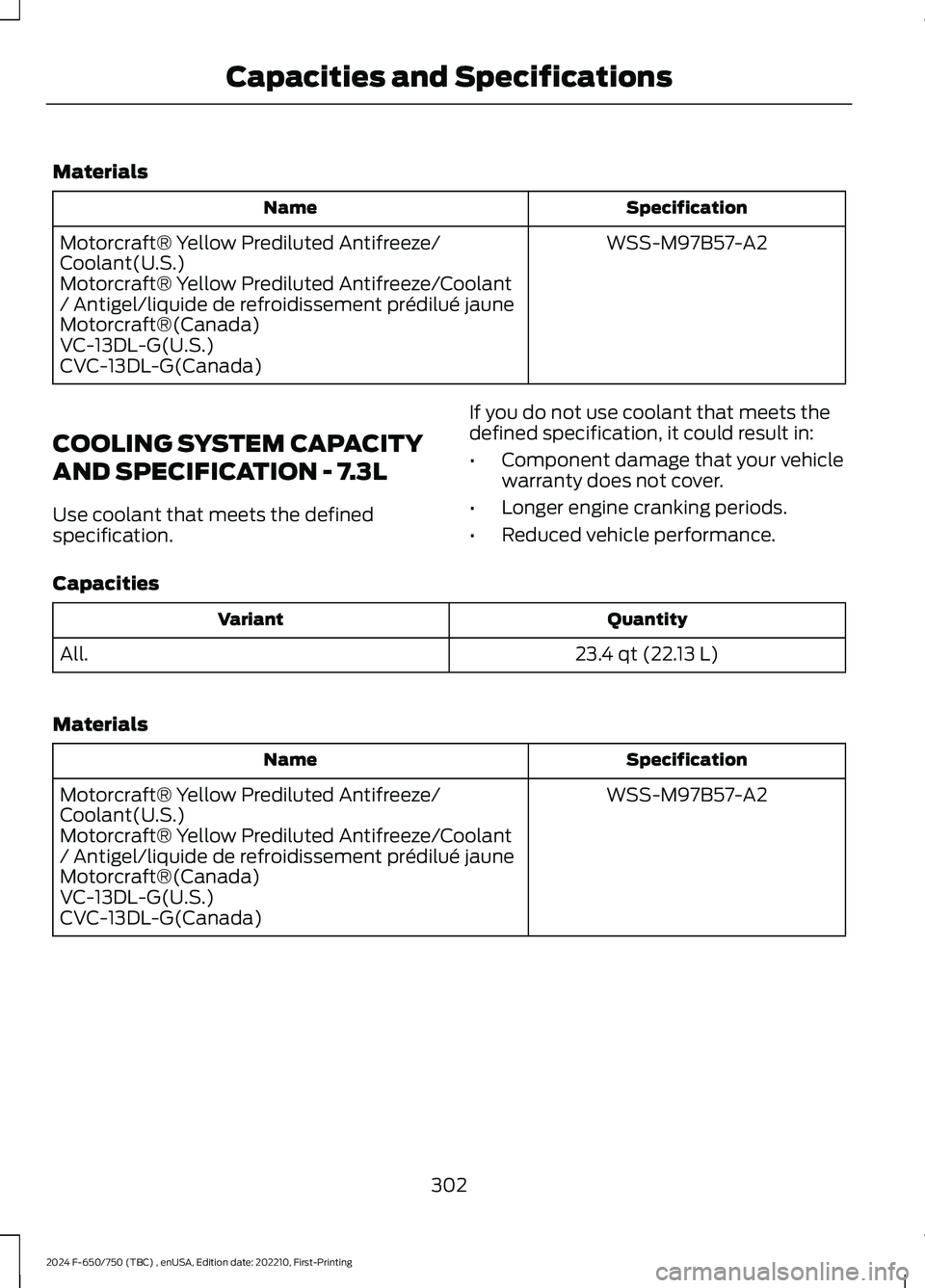2024 FORD F650/750 coolant capacity
[x] Cancel search: coolant capacityPage 240 of 386

Note: Do not use stop leak pellets, coolingsystem sealants, or non-specified additivesas they can cause damage to the enginecooling or heating systems. Resultingcomponent damage may not be covered bythe vehicle warranty.
It is very important to use predilutedcoolant approved to the correctspecification to avoid plugging the smallpassageways in the engine cooling system.See Cooling System Capacity andSpecification (page 301). Do not mixdifferent colors or types of coolant in yourvehicle. Mixing of engine coolants or usingan incorrect coolant may harm the engineor cooling system components and maynot be covered by the vehicle warranty.
Note: Coolants marketed for all makes andmodels may not be approved to Fordspecifications and may cause damage tothe cooling system. Resulting componentdamage may not be covered by the vehicleWarranty.
If the coolant level is at or below theminimum mark, add prediluted coolantimmediately.
For vehicles with overflow coolant systemswith a non-pressurized cap on the coolantrecovery system, add coolant to thecoolant recovery reservoir when the engineis cool. Add prediluted coolant to themaximum level. For all vehicles which havea coolant degas system with a pressurizedcap, or if it is necessary to remove thecoolant pressure relief cap on the radiator,follow these steps to add engine coolant:
1.Turn the engine off and let it cool.
2.Unscrew the cap slowly. Any pressureescapes as you unscrew the cap.
3.Fill the coolant reservoir slowly withprediluted engine coolant to within theminimum and maximum range on theengine coolant reservoir. If youremoved the radiator cap in anoverflow system, fill the radiator until
the coolant is visible and the radiatoris almost full. If coolant is added tobring the level within the minimum andmaximum range when the engine is notcold, the system may remain underfilled.
4.Replace the coolant reservoir cap, turnit clockwise until you feel a strongresistance.
5.Check the coolant level in the coolantreservoir the next few times you driveyour vehicle. If necessary, add enoughprediluted engine coolant to bring thecoolant level to the proper level.
Note:If prediluted coolant is not available,use the approved antifreeze concentratediluting it to 50/50 with distilled water. SeeCooling System Capacity andSpecification (page 301). Using water thathas not been deionized may contribute todeposit formation, corrosion or plugging ofthe small cooling system passageways.
If you have to add more than 1.1 qt (1 L) ofengine coolant per month, have yourvehicle checked as soon as possible.Operating an engine with a low level ofcoolant can result in engine overheatingand possible engine damage.
Note:During normal vehicle operation, thecoolant may change color from orange topink or light red. As long as the coolant isclear and uncontaminated, this color changedoes not indicate the coolant has degradednor does it require the coolant to be drained,the system to be flushed, or the coolant tobe replaced.
In case of emergency, you can add a largeamount of water without predilutedcoolant to reach a vehicle service location.On arrival do the following:
1.Drain the cooling system.
2.Chemically clean the cooling system.We recommend Motorcraft PremiumCooling System Flush.
236
2024 F-650/750 (TBC) , enUSA, Edition date: 202210, First-PrintingMaintenance
Page 243 of 386

WARNING: To reduce the risk ofpersonal injury, make sure the engine iscool before unscrewing the coolantpressure relief cap. The cooling systemis under pressure. Steam and hot liquidcan come out forcefully when you loosenthe cap slightly.
WARNING: Do not add coolantfurther than the MAX mark.
When the engine is cold, check theconcentration and level of the coolant atthe intervals listed in the scheduledmaintenance information. See ScheduledMaintenance (page 325).
Note:Make sure that the coolant level isbetween the MIN and MAX marks on thecoolant reservoir.
Note: Coolant expands when it is hot. Thelevel may extend beyond the MAX mark.
Maintain coolant concentration within48% to 50%, which equates to a freezepoint between -30°F (-34°C) and -34°F(-37°C). Check the coolant concentrationusing a refractometer. We do notrecommend the use of hydrometers orcoolant test strips for measuring coolantconcentration.
Adding Coolant
WARNING: Do not add enginecoolant when the engine is on or thecooling system is hot. Failure to followthis instruction could result in personalinjury.
WARNING: Do not remove thecoolant reservoir cap when the engine ison or the cooling system is hot. Wait 10minutes for the cooling system to cooldown. Cover the coolant reservoir capwith a thick cloth to prevent thepossibility of scalding and slowly removethe cap. Failure to follow this instructioncould result in personal injury.
Note: Automotive fluids are notinterchangeable. Do not use coolant orwindshield washer fluid outside of itsspecified function and vehicle location.
Note: Do not use stop leak pellets, coolingsystem sealants, or non-specified additivesas they can cause damage to the enginecooling or heating systems. Resultingcomponent damage may not be covered bythe vehicle Warranty.
It is very important to use predilutedcoolant approved to the correctspecification in order to avoid plugging thesmall passageways in the engine coolingsystem. See Cooling System Capacityand Specification (page 302). Do not mixdifferent colors or types of coolant in yourvehicle. Mixing of engine coolants or usingan incorrect coolant may harm the engineor cooling system components and maynot be covered by the vehicle Warranty.
Note: Coolants marketed for all makes andmodels may not be approved to ourspecifications and may cause damage tothe cooling system. Resulting componentdamage may not be covered by the vehicleWarranty.
If the coolant level is at or below theminimum mark, add prediluted coolantimmediately.
239
2024 F-650/750 (TBC) , enUSA, Edition date: 202210, First-PrintingMaintenance
Page 244 of 386

For vehicles with overflow coolant systemswith a non-pressurized cap on the coolantrecovery system, add coolant to thecoolant recovery reservoir when the engineis cool. Add prediluted coolant to themaximum level. For all vehicles which havea coolant degas system with a pressurizedcap, or if it is necessary to remove thecoolant pressure relief cap on the radiator,follow these steps to add engine coolant:
1.Turn the engine off and let it cool.
2.Unscrew the cap slowly. Any pressureescapes as you unscrew the cap.
3.Fill the coolant reservoir slowly withprediluted engine coolant to within theminimum and maximum range on theengine coolant reservoir. If youremoved the radiator cap in anoverflow system, fill the radiator untilthe coolant is visible and the radiatoris almost full. If coolant is added tobring the level within the minimum andmaximum range when the engine is notcold, the system may remainunderfilled.
4.Replace the coolant reservoir cap. Turnthe cap clockwise until it contacts thehard stop.
5.Check the coolant level in the coolantreservoir the next few times you driveyour vehicle. If necessary, add enoughprediluted engine coolant to bring thecoolant level to the proper level.
Note:If prediluted coolant is not available,use the approved antifreeze concentratediluting it to 50/50 with distilled water. SeeCooling System Capacity andSpecification (page 302). Using water thathas not been deionized may contribute todeposit formation, corrosion or plugging ofthe small cooling system passageways.
If you have to add more than 1.1 qt (1 L) ofengine coolant per month, have yourvehicle checked as soon as possible.Operating an engine with a low level ofcoolant can result in engine overheatingand possible engine damage.
Note:During normal vehicle operation, thecoolant may change color from orange topink or light red. As long as the coolant isclear and uncontaminated, this color changedoes not indicate the coolant has degradednor does it require the coolant to be drained,the system to be flushed, or the coolant tobe replaced.
Note:In case of emergency, you can add alarge amount of water without coolant inorder to reach a vehicle service location.Water alone, without coolant, can causeengine damage from corrosion, overheatingor freezing. When you reach a servicelocation, you must have the cooling systemdrained, flushed and refilled using thecorrect specification prediluted coolant orantifreeze concentrate. See CoolingSystem Capacity and Specification (page302).
Do not use the following as a coolantsubstitute:
•Alcohol.
•Methanol.
•Brine.
•Any coolant mixed with alcohol ormethanol antifreeze.
Alcohol and other liquids can cause enginedamage from overheating or freezing.
Do not add extra inhibitors or additives tothe coolant. These can be harmful andcompromise the corrosion protection ofthe coolant.
Recycled Coolant
We do not recommend the use of recycledcoolant as an approved recycling processis not yet available.
240
2024 F-650/750 (TBC) , enUSA, Edition date: 202210, First-PrintingMaintenance
Page 305 of 386

Note:If you use your vehicle regularly abovethe altitude of 7,500 ft (2,286 m) and underthe temperature of -4.0°F (-20°C), it isrecommended to use the alternative engineoil.
COOLING SYSTEM CAPACITY
AND SPECIFICATION - 6.7L
DIESEL
Use coolant that meets the definedspecification.
If you do not use coolant that meets thedefined specification, it could result in:
•Component damage that your vehiclewarranty does not cover.
•Longer engine cranking periods.
•Reduced vehicle performance.
Note:We recommend an engine blockheater at temperatures below –10°F(–23°C).
Capacities
QuantityVariant
36.4 qt (34.42 L)Primary cooling system.
15.5 qt (14.64 L)Secondary cooling system.
301
2024 F-650/750 (TBC) , enUSA, Edition date: 202210, First-PrintingCapacities and SpecificationsE240523
Page 306 of 386

Materials
SpecificationName
WSS-M97B57-A2Motorcraft® Yellow Prediluted Antifreeze/Coolant(U.S.)Motorcraft® Yellow Prediluted Antifreeze/Coolant/ Antigel/liquide de refroidissement prédilué jauneMotorcraft®(Canada)VC-13DL-G(U.S.)CVC-13DL-G(Canada)
COOLING SYSTEM CAPACITY
AND SPECIFICATION - 7.3L
Use coolant that meets the definedspecification.
If you do not use coolant that meets thedefined specification, it could result in:
•Component damage that your vehiclewarranty does not cover.
•Longer engine cranking periods.
•Reduced vehicle performance.
Capacities
QuantityVariant
23.4 qt (22.13 L)All.
Materials
SpecificationName
WSS-M97B57-A2Motorcraft® Yellow Prediluted Antifreeze/Coolant(U.S.)Motorcraft® Yellow Prediluted Antifreeze/Coolant/ Antigel/liquide de refroidissement prédilué jauneMotorcraft®(Canada)VC-13DL-G(U.S.)CVC-13DL-G(Canada)
302
2024 F-650/750 (TBC) , enUSA, Edition date: 202210, First-PrintingCapacities and Specifications
Page 382 of 386

Changing the Wiper Blades.....................250Charging a Device..........................................98Checking the Wiper Blades.....................249Child Restraint and SeatbeltMaintenance.................................................45Child Restraint Positioning.........................35Child Safety......................................................25General Information............................................25Child Safety Locks.........................................36Cleaning Products.......................................262Cleaning the Engine...................................264Cleaning the Exterior..................................263Cleaning the Instrument Panel andInstrument Cluster Lens........................266Cleaning the Interior...................................265Cleaning the Wheels..................................266Cleaning the Windows and WiperBlades...........................................................265Climate Control..............................................86Cold Weather Precautions - 6.7LDiesel..............................................................187Cold Weather Precautions - 7.3L............188Connected Vehicle.......................................314Connected Vehicle –Troubleshooting.............................................314Connecting the Vehicle to a MobileNetwork.............................................................314Connected Vehicle Limitations...............314Connected Vehicle Requirements..........314Connected Vehicle –Troubleshooting.........................................314Connected Vehicle – Frequently AskedQuestions.........................................................314Connecting a Bluetooth® Device...........318Connecting the Vehicle to a MobileNetwork.........................................................314Connecting FordPass to the Modem..........314Enabling and Disabling the Modem............314What Is the Modem...........................................314Coolant CheckSee: Engine Coolant Check - 6.7LDiesel.................................................................235See: Engine Coolant Check - 7.3L................238Cooling System Capacity andSpecification - 6.7L Diesel......................301Cooling System Capacity andSpecification - 7.3L...................................302
Crash and Breakdown Information.......194Automatic Crash Shutoff................................195Cruise Control................................................158Cruise Control Indicators...........................159Cruise Control - Vehicles With: AdaptiveCruise Control...............................................52Cruise Control - Vehicles With: CruiseControl.............................................................52Customer Assistance.................................196Customer Information...............................345Radio Frequency CertificationLabels................................................................345
D
Data Recording..................................................11Daytime Running Lamps - Vehicles With:Configurable Daytime RunningLamps..............................................................57Daytime Running Lamps - Vehicles With:Daytime Running Lamps (DRL).............57Diesel Exhaust Fluid Capacity andSpecification...............................................307Diesel Particulate Filter..............................124Direction Indicators.......................................58Doors and Locks.............................................49Draining the Fuel Filter Water Trap - 6.7LDiesel.............................................................234Driver Alert......................................................166Driving Aids.....................................................166Driving Hints...................................................186Driving Through Water...............................189DRLSee: Daytime Running Lamps - Vehicles With:Configurable Daytime Running Lamps....57See: Daytime Running Lamps - Vehicles With:Daytime Running Lamps (DRL).................57
E
Economical Driving......................................187Electrical System Inspection...................254Electromagnetic Compatibility...............351Emission Law...................................................117End User License Agreement.................354Engine Block Heater....................................105Engine Coolant Check - 6.7LDiesel.............................................................235
378
2024 F-650/750 (TBC) , enUSA, Edition date: 202210, First-PrintingIndex
Page 383 of 386

Engine Coolant Check - 7.3L....................238Engine Emission Control.............................117Engine Idle Shutdown................................105Engine ImmobilizerSee: Passive Anti-Theft System......................51Engine Oil Capacity and Specification -6.7L Diesel...................................................296Engine Oil Capacity and Specification -7.3L.................................................................299Engine Oil Check...........................................227Engine Oil Dipstick - 6.7L Diesel.............227Engine Oil Dipstick - 7.3L...........................227Engine Specifications - 6.7L Diesel........291Engine Specifications - 7.3L.....................292Entering, Exiting or Climbing on ThisVehicle..............................................................18Environment.....................................................22Essential Towing Checks...........................183Event Data RecordingSee: Data Recording..............................................11Exhaust Brake................................................145Exhaust System Inspection.....................255Export Unique Options.................................18Exterior Mirrors.................................................61
F
Fastening the Seatbelts..............................39Federal Highway AdministrationRegulation.......................................................18Fifth Wheel Operation................................184Flat TireSee: Changing a Road Wheel........................287Ford Credit.........................................................15Ford Protect...................................................323Frame and Tow Hook Inspection..........260Front Seat Armrest........................................95Fuel and Refueling.......................................107Fuel Consumption.........................................115Fuel Filter - 7.3L............................................249Fuel Quality - Diesel....................................108Fuel Quality - Gasoline.................................111Fuel Tank Capacity - Diesel.....................303Fuel Tank Capacity - Gasoline...............304Fuel Tank Selector Switch.........................116Fuses................................................................202Fuse Specification Chart..........................202
G
Gauges...............................................................64GearboxSee: Transmission..............................................130General Driving Points................................186General Information on RadioFrequencies...................................................46General Maintenance Information........325Getting Assistance Outside the U.S. andCanada..........................................................199Getting the Services You Need...............196
H
HandbrakeSee: Parking Brake.............................................140Hazard Flashers............................................190Headlamp AdjustingSee: Adjusting the Headlamps.....................248Headlamp Exit Delay....................................56Headlamp RemovalSee: Removing a Headlamp..........................250HeadrestSee: Head Restraints..........................................89Head Restraints..............................................89Heated Exterior Mirrors................................88HeatingSee: Climate Control..........................................86Hill Start Assist - Vehicles With:Hydraulic Brakes........................................143Hints on Controlling the InteriorClimate............................................................87Hints on Driving With Anti-LockBrakes............................................................140Hood LockSee: Opening and Closing the Hood...........223Horn.....................................................................53How Does the Pneumatic LockingDifferential Work........................................137Hydraulic Power Steering Fluid Capacityand Specification.......................................312
I
Ignition Switch................................................101In California (U.S. Only)..............................197Information Display Control.......................53
379
2024 F-650/750 (TBC) , enUSA, Edition date: 202210, First-PrintingIndex